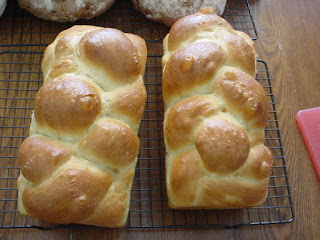
This recipe was inspired by a desire to recreate the rye bread that my great grandmother would make. While I had the recipe, I could never get it to work. All of the measurements were approximate and it called for cake yeast which is rather difficult to find and a pain to work with. However, I had the techniques from Peter Reinhart's "Whole Grain Breads" and his recipe for transitional rye, which is the foundation for this bread. So, here it goes...
"Borkovetz Rye" - Makes 2 one pound sandwich loaves
Pre-dough - Soaker
12 oz white rye flour
4 oz whole wheat flour
1 tsp salt
0.25 oz instant mashed potato flakes
2 oz Saco buttermilk powder
11 oz water at room temperature
Combine all of the soaker ingredients together in a large bowl. They should come together into a ball of dough that is moist but not gummy. Cover bowl with plastic wrap and let stand at room temperature for 12 hours (overnight).
Pre-dough - Biga
16 oz unbleached white bread flour
1/2 tsp instant yeast
10 oz water at room temperature
Combine all of the biga ingredients together in a bowl. Wet hands with cold water and knead for about 2 minutes until all the flour comes together to form a ball of dough. Let stand 5 minutes for flour to hydrate and dough to relax a little. Prepare a large plastic storage container with spray oil. Knead the biga for another minute and then place in the storage container and place the cover of the container on lightly.
Let stand at room temperature. After 2 to 3 hours, the dough should rise a little. Degas the dough, return to container and place the cover tightly on the plastic container. Refrigerate overnight. 2 hours before starting the next day, remove the dough from refrigerator so it can return to room temperature.
Final Dough
2 oz white rye flour
All soaker
1 1/4 tsp salt
All biga
0.50 oz instant yeast
1 oz extra virgin olive oil
2 oz white corn syrup
1 oz honey
0.50 oz whole caraway seeds
Extra white rye flour for adjustment and dusting the board
Substitution for caraway seeds
0.40 oz crushed fennel seeds
0.75 oz dried tomato
Turn out the soaker onto a cutting board dusted with some of the 2 oz of white rye flour. Cut into small pieces with a bread scraper and then return to the bowl. Add the salt. Turn out the biga onto the cutting board, again dusted with some of the 2 oz white rye flour. Again, cut into small pieces and add to bowl. Add yeast, oil, syrup and honey to the bowl. Also add the caraway seeds or the substitution of fennel and tomato. Combine with spoon until components start to come together. As you combine with the spoon, add any remaining white rye flour from the 2 oz measured quantity.
Turn out dough onto a heavily floured board and continue the mixing by kneading. Knead for 6 minutes, dusting the board as little as possible to keep the dough from sticking. Let rest on the board while you prepare a clean bowl for rising with spray oil. Knead the rested dough for another 1 minute, form into a tight ball and place in bowl for rising. Let rise for approximately 60 minutes until about 1 1/2 times size.
After the first rise, turn the dough out onto a lightly floured board and divide into 2 equal pieces. Form each for a loaf pan and place in oiled 8 1/2" bread pans. Spray the top lightly with spray oil and cover loosely with plastic wrap for proofing. Proof for approximately 60 minutes until dough fills out the pans.
15 minutes before baking, remove the plastic wrap and score the top of the bread with a sharp knife. Preheat oven to 425 degrees Fahrenheit. When preheated, place loaves in oven and reduce temp to 350 degrees. Bake for 20 minutes and then rotate so baking is even. Bake for approximately another 20 minutes until the internal temperature registers 190 degrees or higher. Take the loaves out of oven, remove from baking pans immediately and let stand on cooling rack. Cover the loaves with towel and let cool for at least 1 hour before slicing to allow the crumb to set.
UPDATE - You can substitute 13 oz if fresh buttermilk for the dry milk and water. The flavor turns out better. You will also get a better result of you drop the temp to 325 degrees and bake for a total of 60 minutes (30 minutes, rotate and 30 more).


















































